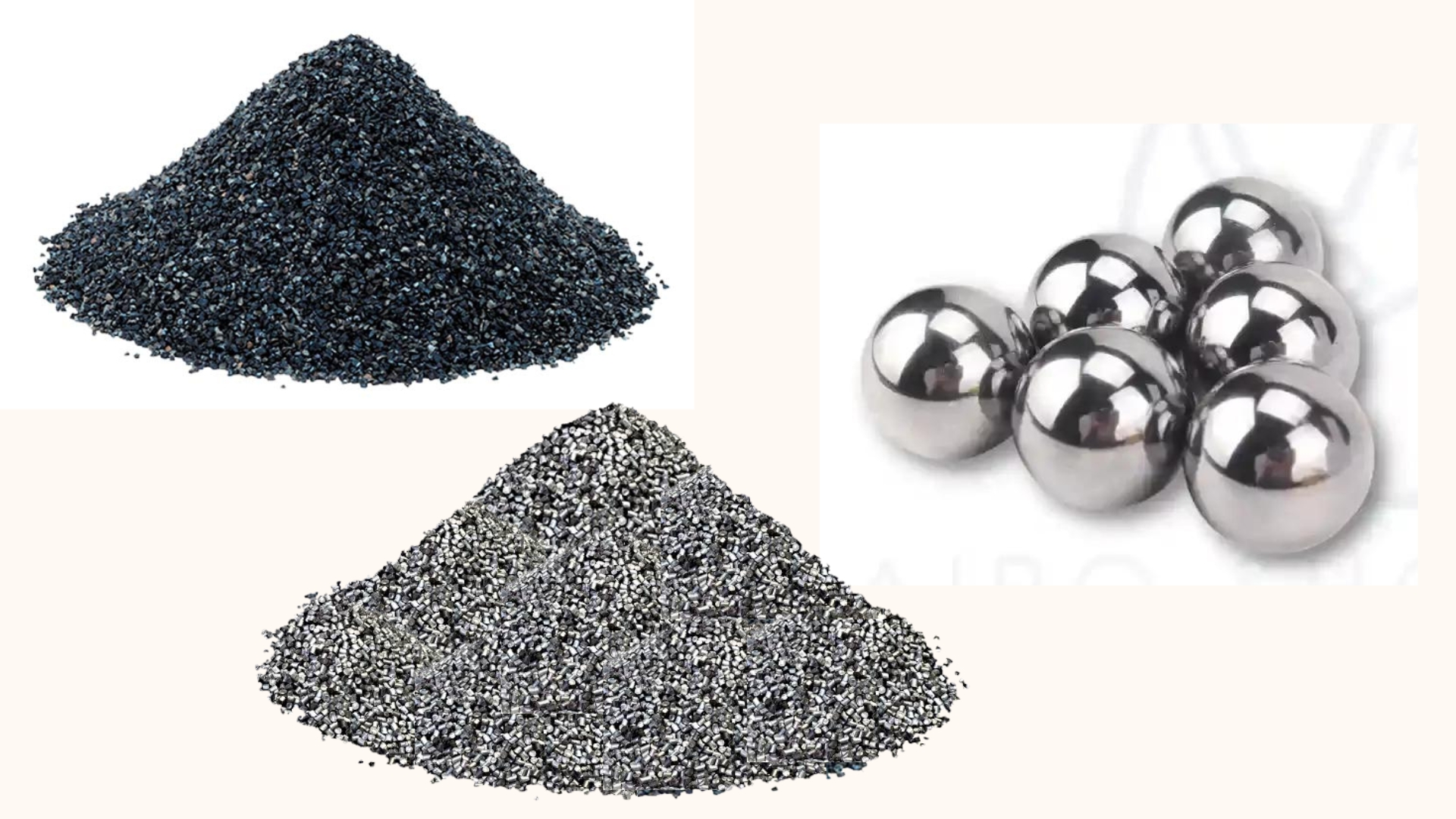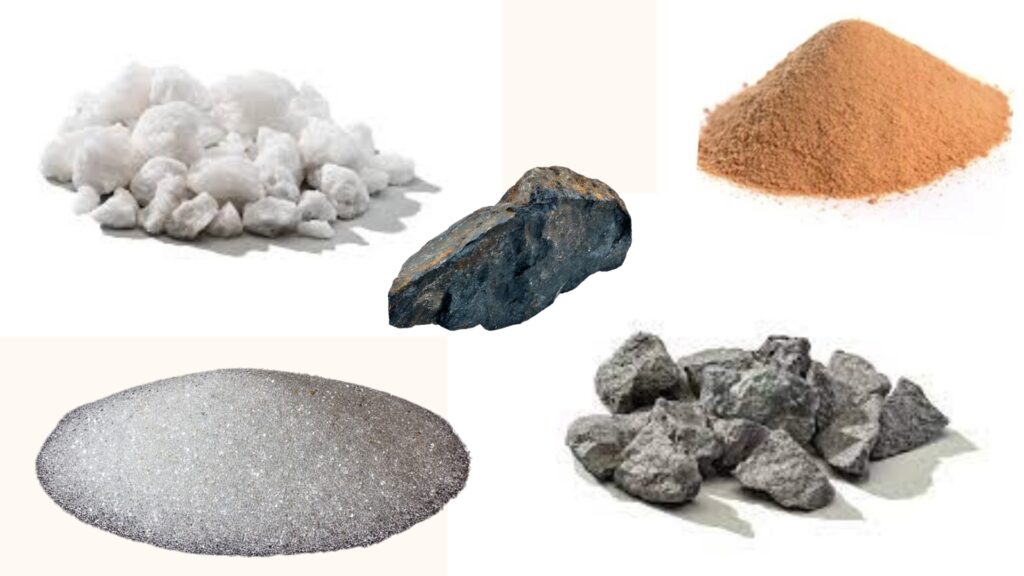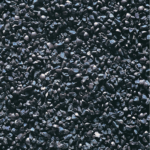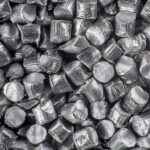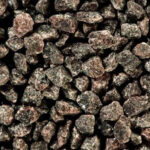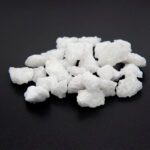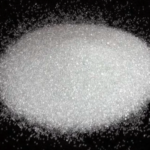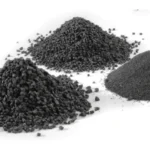
The best natural abrasives are Garnet Sand. Garnet Sand also known as garnet abrasive is naturally occurring mineral abrasive with high hardness & excellent abrasive properties. It is derived from the mineral garnet, which is typically found in certain igneous rocks, metamorphic rocks, and beach sands.
As Garnet is naturally occurred mineral, it have much impurities like iron & mica, which can effect on its performance. To overcome that problem, we double wash the garnet & demagnetize it to remove iron particles & low dense mica material, which raise the Garnet density as well as performance. Moreover we use the pure water during the washing process which helps to maintain the Garnet conductivity.
Our Product Standards
Edit Content
| Minerals | Results |
|---|---|
| Garnet | 97-98% |
| Ilmenite | 01-02% |
| Others | ˂00.10% |
Edit Content
| Element | Results |
|---|---|
| SiO2 | 33-38% |
| Al2O3 | 21-22% |
| Fe2O3 | 31-38% |
| CaO | 1.5-2% |
| MgO | 07-08% |
| MnO | 0.5% Approx. |
| TiO2 | ˂1.5% |
Edit Content
| Parameter | Results |
|---|---|
| Color | Reddish Brown |
| Appearance | Crystalline, Sharp, Angular |
| Melting Point | ≥ 1200 °C |
| Conductivity | Max 15 mS/m |
| Specific Gravity | 3.9-4.3 |
| Bulk Density | 2.1-2.7 g/cm3 |
| Hardness | Min 7.5 Mohs |
| Moisture | Max 0.25% |
| Toxic Substance | None |
| Suspended Solid | Max 1500 mg/l |
| Odor | No Odor |
| Gypsum | Nil |
| Metal Content | Traces |
| PH of Aquarius Medium | 6.9-7 |
| Solubility in Water & Acid | Insoluble |
| Soluble Salt | ˂100 PPM |
| Chloride | ˂50 PPM |
| Lead (P2O5) | ˂ 0.05% |
Edit Content
| Application | Grade |
|---|---|
| Water Filtration | A+ (12x20)/A (12x25) |
| Oil Filtration | B (20x40)/C (30x50/60) |
| Sand Blasting | A+ (12x20)/A (12x25)/ B (20x40)/C (30x50/60)/ D+ (40x60) |
| Water Jet | D+ (40x60)/D (50-80)/ |
| E (120) |
Edit Content
| 1. Collecting Stones or Sand from Mines & Beach |
|---|
| 2. Crushing Stones |
| 3. Acid Wash |
| 4. Normal Water Wash |
| 5. Grading in Different Sizes |
| 6. Drying & Blowing |
| 7. Packing & Forwarding |
Edit Content
| Size/Grade | Size/Grade | A+ | A | B | C | D+ | D | E |
|---|---|---|---|---|---|---|---|---|
| Mesh | Micron | 1700-850 | 1400-600 | 850-425 | 600-250 | 425-180 | 300-180 | 180-125 |
| Retained | Retained | % | % | % | % | % | % | % |
| 12 | 1700 | <03 | 0 | |||||
| 14 | 1400 | 10-21 | <03 | |||||
| 18 | 1000 | 70-85 | 10-25 | 0 | ||||
| 20 | 850 | 0-7 | 30-45 | <03 | 0 | |||
| 25 | 710 | <03 | 30-50 | 2-10 | <01 | |||
| 30 | 600 | 02-10 | 30-45 | 02-05 | 0 | |||
| 40 | 425 | <03 | 40-60 | 05-20 | <0.20 | 0 | ||
| 45 | 355 | <07 | 15-40 | - | <02 | |||
| 50 | 300 | 45-60 | 20-35 | 04-12 | <0.10 | |||
| 60 | 250 | 00-05 | 40-55 | 20-35 | <0.30 | |||
| 70 | 212 | <01 | - | 30-45 | 02-05 | |||
| 80 | 180 | 15-30 | 10-25 | 10-25 | ||||
| 100 | 150 | 00-05 | 4-10 | 15-50 | ||||
| 120 | 125 | <01 | <05 | 5-10 | ||||
| 140 | 106 | 02-04 | ||||||
| 170 | 090 | <0.50 |
Garnet Sand & its Importance
Edit Content
Suggested Grades :
| WATER FILTERATION | COARSE | A+/A |
| FINES | D+/D/E |
Garnet is commonly used in water filtration systems, particularly in the form of garnet sand or garnet filter media. It serves as a highly effective and efficient filter medium due to its unique physical and chemical properties. The use of garnet in water filtration helps remove impurities and particles from water, making it suitable for various applications, including drinking water, industrial processes, and wastewater treatment.
Here’s how garnet is utilized in water filtration :
Filtration Media :
Garnet is used as a granular filter media in various types of filtration systems, such as multi-media filters and rapid gravity filters. The garnet filter media is placed in a filter bed, and water is passed through it. As water flows through the filter bed, suspended particles and impurities are trapped in the spaces between the garnet grains, effectively removing them from the water.
High Density and Uniformity :
Garnet’s high density and uniformity of particle size contribute to its effectiveness in filtration. Its relatively high specific gravity allows for excellent particle retention, ensuring efficient filtration.
Chemically Inert :
Garnet is chemically inert and does not react with water or most other chemicals, making it a safe and reliable filtration medium. It does not add any unwanted substances to the filtered water.
Abrasive Properties :
Garnet’s natural abrasive properties also contribute to its filtration capabilities. As water passes through the garnet bed, the irregularly shaped grains create turbulence, which helps in dislodging and trapping fine particles in the filter.
Longevity and Reusability :
Garnet is a durable and hard material, which means it has a long service life as a filter medium. It can withstand prolonged exposure to water flow without significant degradation. Additionally, garnet can be cleaned and reused several times before requiring replacement, making it a cost-effective option for water filtration.
Non-Clogging :
Garnet filter media is known for its non-clogging nature, meaning it does not easily block or become compacted over time. This ensures consistent flow rates and efficient filtration performance.
Removal of Sediment and Turbidity :
Garnet is particularly effective in removing suspended solids, sediment, and turbidity from water. It can help produce clear and visually appealing water suitable for various applications.
Garnet is especially popular in industrial water treatment applications, where large quantities of water need to be filtered to remove contaminants before use or discharge. It is also commonly used in community water treatment plants, swimming pools, and other commercial and residential filtration systems.
Overall, garnet’s physical and chemical characteristics make it a reliable and widely used natural filtration medium for a variety of water treatment applications.
Edit Content
Suggested Grades :
| OILFILTERATION | COARSE | B or C |
Garnet is also used in oil filtration processes, where it plays a crucial role in removing impurities and contaminants from various types of oils. Its natural properties, including high hardness, chemical inertness, and uniformity, make it an effective and popular choice for oil filtration applications. Garnet is employed in both industrial and commercial settings to ensure the purity and cleanliness of oils used in machinery, engines, and hydraulic systems.
Here’s how garnet is utilized in oil filtration :
Filtration Media :
Garnet is used as a filter media in oil filtration systems. It is available in various particle sizes, allowing for the selection of the appropriate grade based on the specific requirements of the oil filtration process.
Particle Removal :
As oil flows through the garnet filter bed, the porous spaces between the garnet grains trap and remove solid particles and contaminants present in the oil. These can include dirt, metal particles, debris, and other impurities that may be harmful to the performance and longevity of machinery and engines.
Chemically Inert :
Garnet is chemically inert and does not react with oils or most other chemicals. This ensures that the filtered oil remains free from any additional impurities introduced by the filter media.
High Flow Rate :
Garnet’s non-clogging nature and abrasive properties promote consistent flow rates during oil filtration, ensuring that the process is efficient and doesn’t lead to pressure drop or interruptions.
Long Service Life :
Garnet is a durable material with a long service life. It can withstand the harsh conditions of oil filtration, such as high temperatures and pressure, without significant wear or degradation.
Enhanced Oil Quality :
By removing contaminants and particulates from oil, garnet filtration helps maintain the overall quality and performance of the oil. Clean oil is essential for reducing friction, minimizing wear and tear, and extending the life of machinery and engines.
Cost-Effectiveness :
Garnet’s longevity and ability to be cleaned and reused multiple times make it a cost-effective choice for oil filtration applications. It reduces the frequency of filter replacement, leading to cost savings over time.
Garnet is commonly used in various types of oil filtration systems, including bypass filters, full-flow filters, and offline filtration units. It is employed in industrial settings, such as power generation plants, manufacturing facilities, and oil refineries, as well as in commercial applications for automotive engines and hydraulic systems.
Overall, garnet’s properties make it a reliable and efficient natural filtration medium for oil purification, ensuring that oils are free from contaminants and meet the required cleanliness standards for optimal performance and equipment longevity.
Garnet Blasting :

| BLASTING MEDIA | HIGHPROFILE | A+ A B C |
| LOWPROFILE | D+ D E |
Garnet is widely used as an abrasive material in blasting applications due to its hardness, sharp edges, and ability to withstand high pressure. Garnet blasting, also known as garnet sandblasting or garnet abrasive blasting, is a popular method for surface preparation, cleaning, and finishing in various industries. It is considered an environmentally friendly and cost-effective alternative to other abrasive materials.
Here’s how garnet is utilized in oil filtration :
Surface Preparation :
Garnet blasting is commonly used for surface preparation before painting, coating, or other surface treatments. It effectively removes rust, scale, old paint, and other contaminants from the surface, ensuring proper adhesion of the new coating and prolonging its durability.
Abrasive Blasting Systems :
Garnet can be used in various types of abrasive blasting systems, such as dry blasting and wet blasting. In dry blasting, garnet is propelled at high speed through a blasting nozzle using compressed air. In wet blasting, garnet is mixed with water to form slurry and then propelled onto the surface.
Removal of Coatings :
Garnet blasting can efficiently remove coatings, such as paint, epoxy, and varnish, from different surfaces. It is particularly effective in removing thick or stubborn coatings from metals, concrete, and other materials.
Metal Cleaning :
Garnet blasting can be used for cleaning metal surfaces to remove rust, corrosion, and scale. It leaves the surface clean and prepared for subsequent treatments or coatings.
Deburring and DE flashing :
Garnet blasting is used for deburring and DE flashing operations in the manufacturing of metal and plastic components. It helps remove sharp edges and excess material from parts, achieving a smooth and finished appearance.
Stone and Glass Etching :
Garnet is used in sandblasting cabinets for artistic etching on stone, glass, and other materials. It provides precise control over the blasting process and allows for detailed designs and patterns to be created.
Non-Toxic and Recyclable :
Garnet is a non-toxic and inert abrasive, making it a safe choice for blasting applications. It also has excellent recyclability, and used garnet can be collected, cleaned, and reused multiple times, reducing waste and lowering the overall blasting cost.
Low Dust Generation :
Garnet blasting generates less dust compared to some other abrasive materials, making it a preferred choice in applications where dust control is important.
Garnet blasting is used in various industries, including construction, automotive, aerospace, marine, and manufacturing. It offers excellent results with minimal surface damage, making it suitable for delicate or precision blasting applications. The choice of garnet grain size and blasting pressure can be adjusted based on the specific requirements of the project, making garnet a versatile and effective abrasive material for blasting purposes.
Edit Content
Suggested Grades :

| Waterjet Cutting | Waterjet Cutting | D D+ E |
Garnet sand is a popular abrasive material used in waterjet cutting processes. Waterjet cutting is a modern and efficient cutting method that utilizes a high-pressure jet of water mixed with abrasive particles to cut through various materials, such as metal, stone, glass, ceramics, and composites.
Here’s how garnet sand is used in waterjet cutting :
Abrasive Material :
Garnet sand is one of the most commonly used abrasives in waterjet cutting due to its excellent properties. It is a natural mineral consisting mainly of almandine and pyrope, which are types of garnet. The grains of garnet are hard and sharp, making them ideal for cutting tough materials.
Mixing with Water :
In the waterjet cutting process, garnet sand is mixed with water to form an abrasive slurry. The mixture is then forced through a nozzle at extremely high pressure, typically ranging from 30,000 to 90,000 pounds per square inch (psi).
Cutting Process :
The high-pressure abrasive waterjet stream exits the nozzle at a very high velocity, which allows it to cut through the material being processed. The abrasive particles in the waterjet hit the surface of the workpiece, effectively eroding and cutting through the material.
Versatility :
Garnet sand is preferred in waterjet cutting because it is hard enough to cut through tough materials like metals, yet it is not excessively abrasive, which means it won’t cause excessive wear on the waterjet cutting equipment. It also produces a relatively smooth edge on the cut surface, reducing the need for additional finishing.
Environmental Considerations :
Garnet is a natural and non-toxic mineral, making it a safer and more environmentally friendly choice compared to some other abrasives used in cutting processes.
Recycling :
After the waterjet cutting process, the abrasive slurry containing garnet and the cut material can be separated using a filtration system. The garnet can be recycled and reused several times before it becomes too small or worn out for effective cutting, reducing waste and overall costs.
Overall, garnet sand is a reliable and efficient abrasive material for waterjet cutting applications, offering a balance between cutting performance, cost-effectiveness, and environmental impact.

